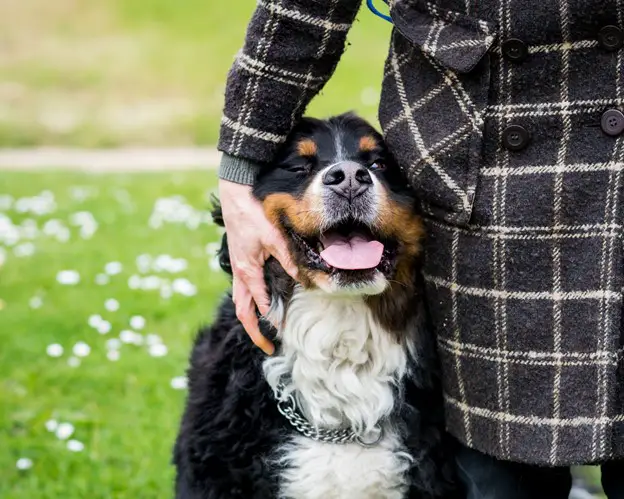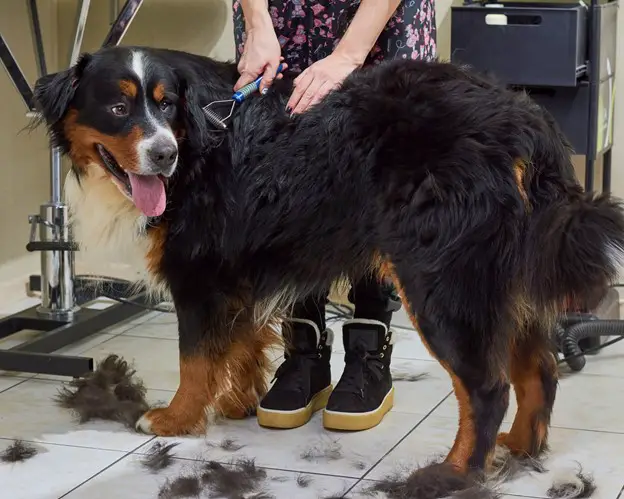The Bernese Mountain Dog (BMD) makes an excellent addition to any family.
BMDs are a loyal, intelligent, and protective breed known to work hard and to love even harder.
Whether running around the yard with the kids, snuggling up on the couch, or accompanying the family on a long outdoor hike, these beautiful dogs are a joy to have in any family home.
However, if we were to ask a Berner owner, “what is the one thing you DON’T love about your pet?” they would likely be unified in the answer: “The crazy amounts of SHEDDING.”
It should come as no surprise that Bernese Mountain Dogs have a tremendous amount of fur. Their full, beautiful coats are one of their most distinctive features and they are famous for their unique coloring and coat pattern.
While gorgeous to look at, it can be challenging to take care of the coat of the Bernese Mountain Dog, especially for an owner who doesn’t understand precisely how much hair they are getting ready to combat in the home.
The Bernese Mountain Dog, bred initially as a working dog in the Swiss Mountains, is one of four types of Swiss Mountain Dogs and the only one with long hair.

How Bad Does a Bernese Mountain Dog Shed?
The Bernese Mountain Dog scores a strong five out of five on the American Kennel Club’s five-point shedding scale, meaning that the Bernese Mountain Dog shed a LOT.
If you plan to share your home with a Berner, you should also expect to share it with their hair.
You will likely find dog hair on all of your clothes, furniture, and maybe even your family members and visiting friends.
And while the shedding can be somewhat contained, any potential owner should prepare to sacrifice a large portion of their time and budget to grooming needs.
How Do I Stop My Bernese Mountain Dog From Shedding?
Bernese Mountain Dogs will shed their coat year-round. However, you can minimize the shedding of your Bernese Mountain Dog by grooming your Berner regularly. This will keep the hair loss contained. The degree to which the hair is contained depends on how regularly you groom your Bernese Mountain Dog.
The average cost for a professional Berner groom is $85-100, usually based on the individual dog’s size and the groomer’s pricing model.
Though a bit pricey, the groom price for a BMD will include bathing, nail trimming, a total “blow-out” with a high-impact drying tool, anal gland expression, thorough brushing, and trimming of the undercarriage and bloomers – all of which serve to keep the glorious canine’s coat at bay.
Also, another way Berner owners can minimize shedding of their Berner is by brushing their dogs daily to keep up with shedding as much as possible.
Many owners will elect to use a straight thistle brush or a de-shedding tool called a “Furminator,” which brushes through the Berner’s two coat layers and pulls out any loosening fur.
Daily brushing will allow an owner to witness how much of the coat is shedding and remove that portion before it hits the floor.
To minimize shedding, do not bathe your Bernese Mountain Dog more than once per month (unless, of course, they come home dirty due to a romp in the mud or a long day at the beach).
Bathing your Berner too frequently can cause the skin to dry out and deplete valuable natural oils that keep the coat shiny and soft. Without these natural oils, the coat will not be as easily maintained and can result in increased shedding.
When is the Bernese Mountain Dog’s “Shedding Season”?
While Berners shed their coats year-round, they tend to shed more often during specific times of the year.
Most Berners will lose more of their fur in the early summer (as they shed layers in preparation to brave the heat) and in the early winter (as they grow new layers for protection against the winter cold).

Why Do Berners Have Such Thick Coats?
The Bernese Mountain Dog was originally bred to be a vital part of farm life, serving to protect the family, herd or drive cattle, and pull farm equipment or small carts full of produce and other sellable goods.
Berners are an impressively strong breed that has the ability to pull or carry a load equal to or more than their own body weight. Because they were bred to withstand the mountain weather and terrain, their soft coats are meant to keep them safe from potential threats (such as wolves, coyotes, etc.) and the weather elements. This breed thrives in cold weather and will likely shed its coat more intensely when exposed to a warmer, humid environment.

Does a Bernese Mountain Dog Shed More than a Golden Retriever?
The Bernese Mountain Dog will shed twice as much of their coat in comparison to similar breeds. Golden Retrievers, for example, are known to shed a large amount but are only rated a four on the American Kennel Club’s shedding scale. A four is small in comparison to the Berner, who tips the scale all the way to five.
Bernese Mountain Dogs Shed more than Golden Retrievers. This is because Berners have a higher tendency to shed than Golden Retrievers. Also, Berners are bigger with more body area to shed from than golden retrievers.
Owners of the Berner breed should expect to have hair everywhere. Even breeds comparable in size and body type to the Berner cannot compete with the amount of hair loss. For example, Newfoundlands and Alaskan Malamutes, two different large and furry breeds, will only rate at a three out of five on the same scale!

At What Age Should I Start Grooming My Bernese Mountain Dog?
It is recommended that owners of Baby Berners start their grooming routine as early as 16 weeks old.
Even as puppies, the Bernese mountain dog will shed their coat quickly, and it is important for them to learn to tolerate grooming and brushing at a young age. Owners should plan to start out brushing with a soft-bristled brush and slowly increase the sturdiness of the grooming tool as they grow.
Do not be discouraged if you have a Bernese Mountain Dog who hates being brushed. It is not uncommon for this to be a scary experience for a pet who has not been exposed to the brush. It is of the utmost importance, during training sessions, to be patient and understanding.
If your Berner gets upset during routine brushing, attempt to introduce the brush while they are in a happy state, such as cuddling on the couch or enjoying a good meal. Experts also recommend introducing the brush slowly – starting with five-minute sessions and gradually increasing the time as your pet’s tolerance builds.
Does Diet or Exercise Affect the Amount of Berner Shedding?
Berner coats will also benefit from regular exercise, so make sure to walk and play with your pet regularly. It is a great idea to take your Berner for a long walk around the neighborhood right after a bath. Not only will they enjoy drying out their coat in the warmth of the sun, but this activity can quickly bond you and your pet, making the next bath session less scary and more rewarding.
The Bernese Mountain Dog will shed more as they age. Senior Berners are known to relieve much more of their coat than a young dog. This is due to the decline of hormone activity as their bodies age. Plenty of exercises is essential for an aging Berner as well, allowing for improvements to their overall health and mental state. We want to keep these hormones functioning for as long as we can while our pets age.
In addition to exercise and routine grooming, a complete and balanced diet is another necessary competent to maintaining a healthy and happy Bernese Mountain Dog. Most owners do not consider diet as an attributing factor to coat health, but it is, in reality, directly influential to your pet’s skin and coat. Ensuring the diet that your dog eats is high in Omega Fatty Acids will go a long way in keeping their coats shiny and healthy. While it can take a solid month or longer to see a visible effect of a premium diet, keeping their coat healthy through diet will significantly decrease the amount of hair that your Berner sheds.
For some Berners, diet alone may not be sufficient. In this case, veterinary experts will often recommend the addition of dietary supplements, such as Omega 3’s or fish oil, which will help keep your pet’s coat soft and shiny and keep the shedding to a minimum.
Many types of supplements are available, from chewable tablets to liquid additives. These supplements are designed to be tasty in flavor and texture, making them an easy addition to your pet’s usual diet.
How Does Stress Affect My Pet’s Coat?
If you notice your pet shedding more despite frequent brushing, routine grooming, and a healthy, balanced diet, it may be due to stress or anxiety. Studies show that pets who are experiencing an increased level of stress or anxiety shed their coats at a significantly faster rate. Whether this increased anxiety is due to changes in the home or the aging process, it is always a great idea to seek the advice of your family veterinarian in these situations.
Conclusion
If you are considering a Bernese Mountain Dog as your next family pet, don’t be discouraged by the amount of shedding. While the hair can be a chore to combat, this breed is one of the most loving, protective, and loyal breeds.
In addition to being excellent adult companions, Bernese mountain dogs are known to get along well with most other pets (dogs and cats alike) and are traditionally very gentle with children. With a dedication to a consistent routine, life with a Berner can be joyful, fun, and (mostly) fur-free.


